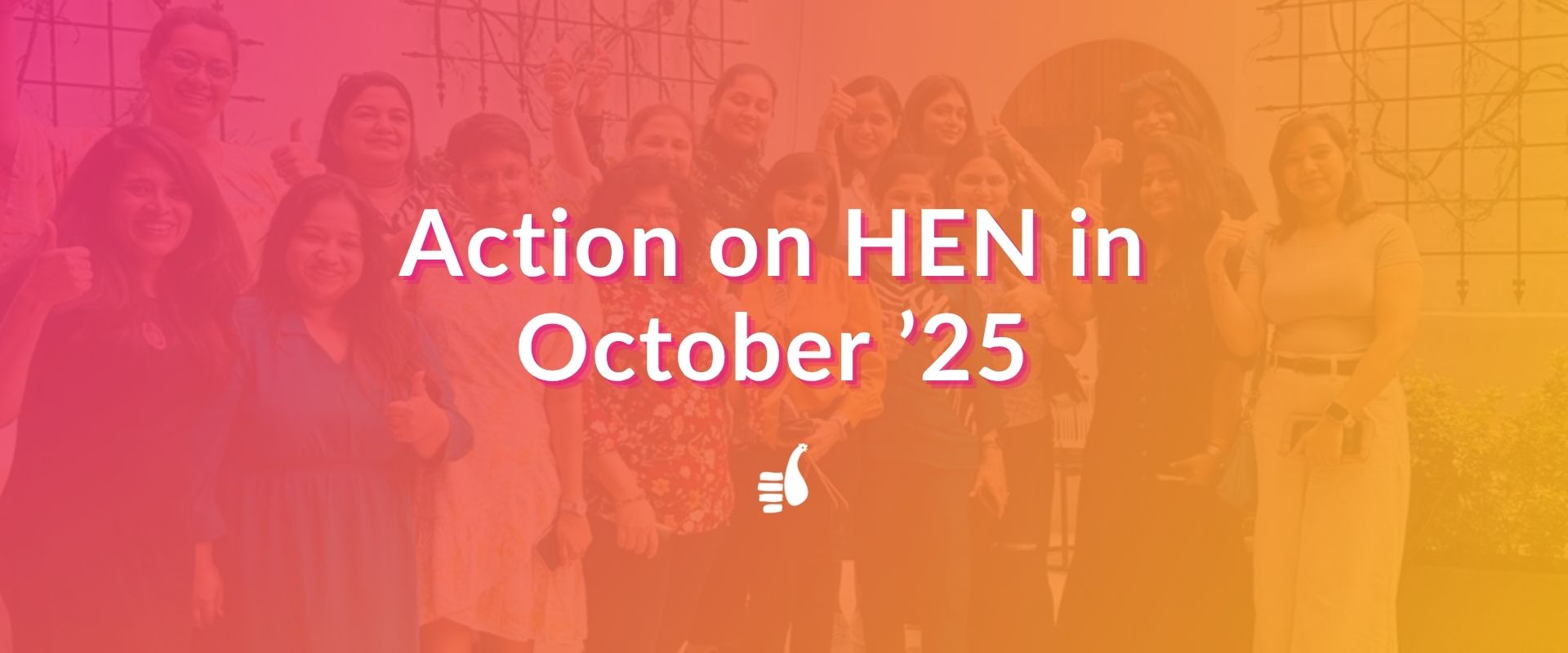Remember the struggle of waiting in long lines for movie tickets or haggling for the perfect Diwali outfit? Those were the ways we used to get entertainment and clothes (the features).
But what did we really want? It wasn’t just standing in line or bargaining; it was about enjoying a movie with loved ones (entertainment) or finding the perfect festive wear (shopping) – the progress we were trying to make.
Now, we’re ready to take a deep dive into a powerful framework that unlocks the true motivations behind those needs: Jobs-to-be-Done (JTBD).
This blog is your comprehensive guide to the world of JTBD.
As an entrepreneur, you’ll gain invaluable insights into:
- What’s Jobs-To-Be-Done
- What isn’t a Job to be Done.
- How Job Stories Ensure Your Team Focuses on Real Customer Needs?
- Progress Making Forces that determine whether a customer chooses you or someone else.
- A script to Kickstart your JTBD Interviews
- Example – How LinkedIn Gets Jobs to be Done
So, buckle up, because we’re about to crack the code on customer needs! Let’s jump into the world of Jobs-to-be-Done!
A Dive Into What's Jobs-To-Be-Done?
- Think about it – you don’t buy products just to let them collect dust.
- You “hire” them to get a specific job done.
New York consultant, Alan Klement describes “Jobs-to-be-Done” as
“The Process a consumer goes through whenever she aims to transform her existing life-situation into a preferred one, but cannot because there are constraints that stop her.”
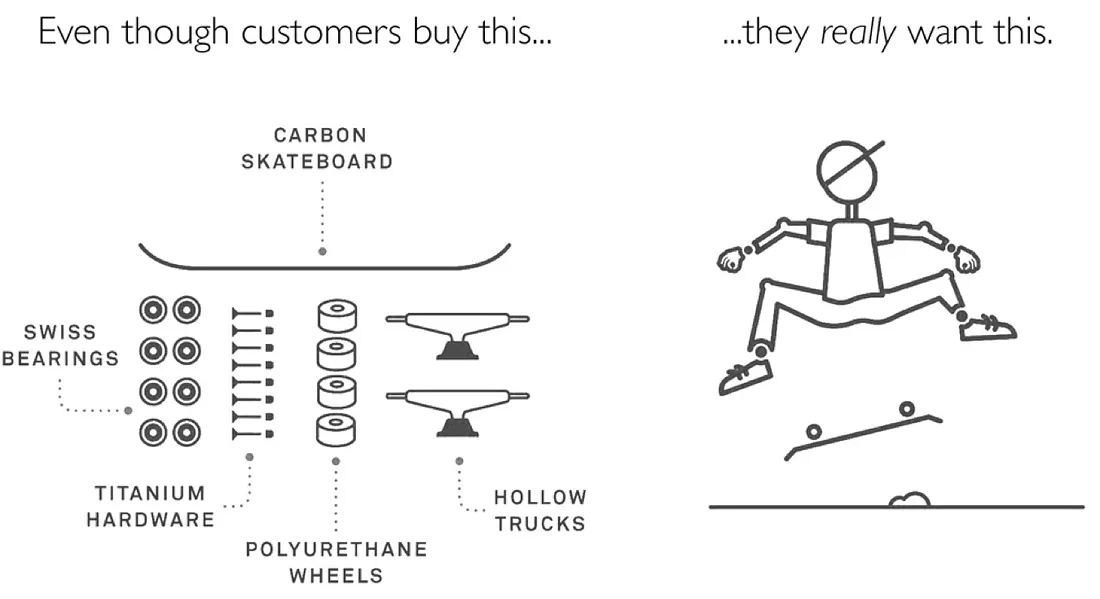
The designers at intercom (intercom.com) use this illustration to show what is, and isn’t, important to customers.
What isn’t a Job to be Done?
Alen Klement explains what isn’t JTBD:
Not Tasks or Activities:
- Mistake: Thinking JTBD describes what you do with a product.
- “Store and retrieve music” or “listen to music” are tasks, not Jobs. These describe how you use a product, not the Job itself.
- Example: Music streaming services like Pandora and Spotify were created to avoid the task of storing and retrieving music from CDs or MP3s.
No Different Types of Jobs:
- Mistake: Thinking there are different types of Jobs (emotional, functional, social).
- Practical Perspective: Every Customer Job is unique, combining different desires (e.g., belonging, self-expression, control).
- Example: Facebook satisfies desires like control, self-expression, and belonging in its unique way.
- Theoretical Perspective: Customer Jobs are design problems, not natural problems.
- No objective way to label a Job as “social,” “personal,” or “emotional.”
- Example: Buying a Ferrari to impress others — is it a social Job or a personal insecurity?
Don’t waste time trying to label Jobs.
Focus on understanding the Job as a unique customer need.
- A Customer Job should describe a “better me.”
- Ask: “How are you better since you started using [product]?”
- If a description of a Customer Job doesn’t focus on progress, it’s probably not a true Customer Job.
Other than these:
A JTBD is not a demographic, a persona, or company-specific; it is not person-specific either.
How Job Stories Ensure Your Team Focuses on Real Customer Needs?
Job Story
Formula: “When I [situation], I want to [motivation], so I can [expected outcome].”

Progress Making Forces
This leads us to the concept of Progress Forces, the four key factors influencing a customer’s decision.
Let’s explore these forces and see how they impact your product’s success.
The Forces of Progress
The forces of progress are the emotions that influence customers’ demand for a product. These forces can explain the overall need for a solution or the demand for a specific product.
Two main groups of forces shape customer demand:
- Push and Pull: These forces create demand.
- Habit and Anxiety: These forces reduce demand.
The customer is in the middle, feeling all these emotions at once. Customers go through a mix of these forces before buying, while searching for and choosing products, using them, and improving their lives with them.
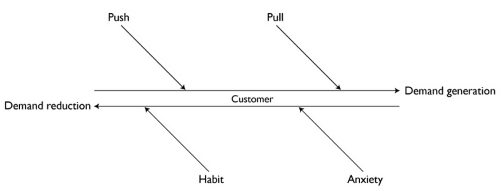
The forces of progress that create and reduce demand
Demand Creation
Demand doesn’t appear out of nowhere. It’s a mix of push and pull forces that drive people to want something new.
- Push: This force comes from dissatisfaction with the current situation.
- Example: Parents with one child manage grocery shopping fine, but with more kids, it becomes stressful and unmanageable, pushing them to look for easier solutions.
- Pull: This is the attraction to a better solution.
- Example: Parents are drawn to the idea of a meal delivery service that promises to make their lives easier.
Types of Push:
- External Pushes: Situations like having multiple kids make tasks like grocery shopping harder.
- Internal Pushes: Personal feelings of frustration or desire for better experiences drive change.
Types of Pull:
- Better Life: People want products that improve their lives.
- Specific Products: People are drawn to particular products they believe will make a difference.

A breakdown of the forces that generate demand
Demand Blockers
Habit and anxiety are your silent competitors.
Anxiety:
- Anxiety-in-Choice: Worrying about whether a new product will work.
- Anxiety-in-Use: Concerns about using a product after trying it.
If I use Clarity, will I sound stupid? Is the call going to be recorded? How is payment handled?
This show seems interesting, but it got bad reviews. Maybe it’s not worth getting tickets for.
How does YourGrocer work? Are there flexible delivery options? Can I get my order today?
Habit:
- Habits-in-Choice: Sticking with a familiar product because it’s what they’re used to.
- Habits-in-Use: Old habits making it hard to stick with a new product.
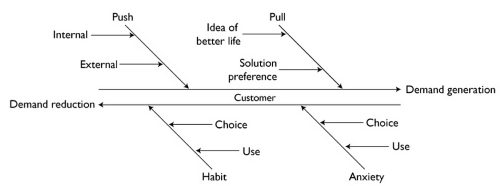
Successful Innovation: Understand and address both push and pull forces as well as anxiety and habits to help customers make progress and choose your product.
Utilize JTBD Forces Of Progress For Your Business
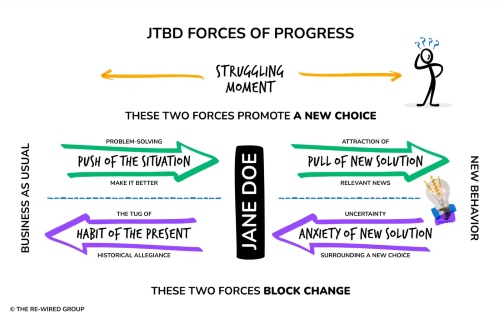
Study Push and Pull:
- Identify Forces: Understand external influences on demand (pushes and pulls).
- Customer Insights: Ask about current solutions and reasons for choice (pushes).
- Alternative Consideration: Inquire about other products considered and decision factors (pulls).
Investigate Habit and Anxiety:
- Recognize Demand Factors: Understand habits and anxieties affecting demand.
- Visualize Benefits: Show progress and benefits to reduce anxiety.
- Mental Support: Assist customers through mental processes and offer trials for reassurance.
- Addressing Habits: Adjust products to help customers overcome old habits.
Retain Customers:
- Learn from Loyal Customers: Compare habits of loyal vs. lost customers for insights.
- Support Struggling Customers: Help struggling customers develop skills to benefit from your product.
A script to Kickstart your JTBD Interviews
Why JTBD Interviews Matter?
JTBD interviews help you RE-LIVE THIS JOURNEY WITH YOUR CUSTOMERS, allowing you to pinpoint the moments they faced challenges and the various solutions they considered, even the unexpected ones.
To understand the job your product is hired to do and the criteria customers use to evaluate it, JTBD interviews are essential. These interviews aim to uncover, in detail, how your customer decided to buy your product. From there, you can analyze and investigate why they made that choice.
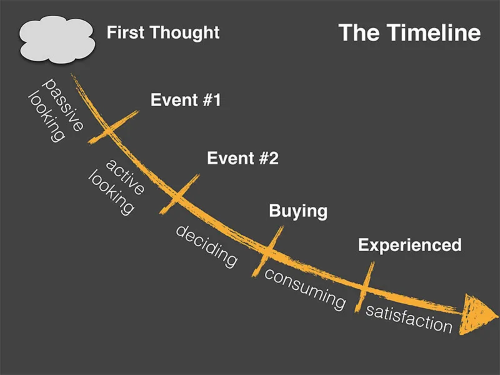
Getting Started: Script and Tips
1. Setting the Scene: The Purchase
Start by setting a comfortable tone for the interview and establishing a timeline. Ask about the purchase:
- When and Where: Where did you buy the product? Was it a local shop, mall, or online?
- The Details: What time of day was it? What was the weather like?
- Company & Context: Were you alone? How did you pay? Did you buy anything else?
- Why? Understand their overall shopping goals.
2. Digging Deeper
Go beyond the purchase itself. Trigger memories by focusing on situations and emotions:
- The First Spark: When did you realize you needed a solution to your problem?
- Where were you? Who were you with? What were you doing?
- Why? Focus on the initial need.
3. Building the Consideration Set
Explore the broader landscape of alternatives your customer considered before choosing you:
- The Search: How did you look for a solution? What options did you consider?
- Why? Understand their decision-making process.
4. Emotions Matter (But Ask Carefully!)
Emotions influence decisions, but don’t ask directly about feelings. Instead:
- Influences: Did others influence your decision?
Imagination: Did you imagine using the product before buying? - Anxiety Check: Did you have any worries or hear anything negative about the product?
Pro Tip: Be cautious about "why" questions.
People often rationalize their actions after the fact. Instead, focus on understanding the emotions and situations that influenced their choices.
Remember: Be genuinely curious, non-judgmental, and actively listen. This encourages customers to share deeper insights, including anxieties and insecurities.
Uncover the Real Job Your Product Does
How Many Interviews Do You Need?
- Usually, patterns emerge after just 5 interviews.
- You shouldn’t need more than 10 to get a clear picture. Stop when you hear the same answers repeatedly.
Finding the Job
- What problem did your product solve for most customers?
- This is the core “job” your product is hired to do.
- It’s okay if your product solves 2-3 similar jobs, but do extra interviews to confirm this isn’t a fluke.
Finding the Hiring Criteria
- Why did they choose you over others
- What held them back from buying sooner?
- What were they looking for?
These answers reveal the criteria they used to “hire” your product. Often, these criteria aim to: Minimize cost, Maximize benefits (revenue, convenience, etc.) and Minimize regret.
By understanding these “jobs” and “criteria,” you can create products and services that truly resonate with your customers!
How LinkedIn Gets Jobs to be Done
- Segmenting Markets: LinkedIn divides its users based on their specific needs and goals. This helps tailor products to align with users’ desired progress.
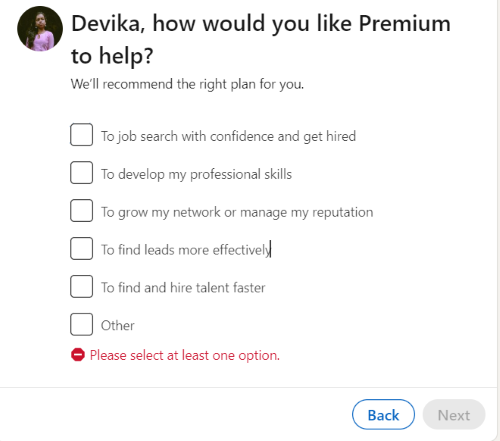
- Tailoring Products: LinkedIn matches its products with identified Jobs to be Done. This ensures each product helps users advance in their careers.
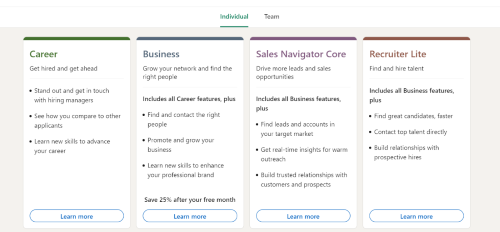
- Product Development: LinkedIn focuses on addressing users’ progress instead of just adding features. This approach ensures the platform meets users’ fundamental needs.
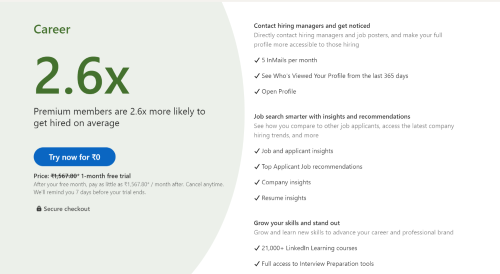
Related Post
Create Products Your Customers Love!
Embrace JTBD, and watch as your products transform from good to truly indispensable for your customers.. By understanding your customers better, you can create products and marketing they love!
Article Contribution by – Devika Kovachi & Sapna Garg



